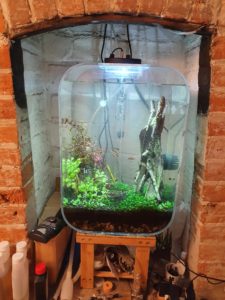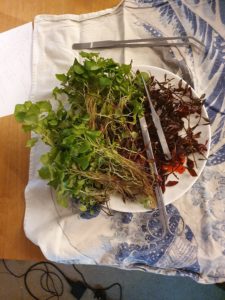The ludwigia had reached well beyond the height of the tank casting a considerable overshadow so it was time for a trim. I had just received a new set of ADA pinsettes and was looking forward to trying them out for replanting the trimmed tops*. It was also time for a water change and I’m switching to a new EI fertiliser scheme** so potentially big changes coming.
Month: February 2021
Plant layers add vertical interest
Aquatic plants for aquaria are commonly classed by how tall they can be expected to grow, with the idea that it is sensible to grow the shortest plants at the front of the tank, middle-sized plants somewhat further back behind the shortest plants, and the tallest plants at the very back. In the community these are generally called, logically enough, foreground, midground and background plants. Of course, you don’t have to follow this scheme and there might be a specific effect you’re trying to achieve by putting taller plants in front of shorter plants, but ideally this would be a deliberate choice and not something you unintentionally discover by accident.
In this video, you can see the effect in action. On the left, at the very front bottom of the tank, low down and in the shadow of the lobelia, is a single dark green line of newly planted cryptocoryne lutea ‘hobbit’ which is expected to grow to a maximum of 5 cm. The aforementioned lobelia cardinalis ‘wavy’, bright green and filling the bottow left quadrant of the tank, was planted six months ago and has topped out at its maximum height of just under 20 cm. In the back of the tank, the red plant arching over the lobelia is ludwigia palustris mini ‘Super Red’ which would be around 45 cm if stretched out to its full length. The very low carpeting plant on the right side all around the base of the mountain is marsilea hirsuta (although if you look carefully, there is another ‘hobbit’ hiding in the bottom right front corner. The marsilea was planted over a year ago and will never get any larger than it is currently. Some people like the look of plants that float on the surface such as frogbit or duckweed, and in a larger setup these can be effective, but I prefer not to go there in this instance.
I like the look of the different horizontal layers of plants on the left, contrasting with the verticality of the mountain sculpture on the right. The fish seem to appreciate the differences too – if they’re nervous they can hide under the lobelia, or explore above the lobelia while still feeling a degree of sheltering protection (or at least so I project upon them) from the overarching ludwigia.
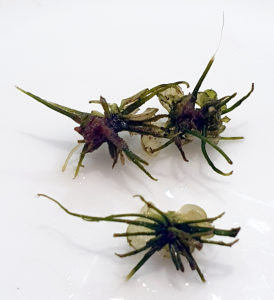
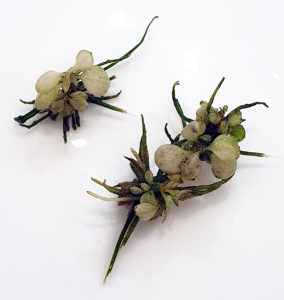
Anubias nana ‘Snow White’ – one month update
It’s been a little over five weeks since I planted anubias nana ‘snow white’ in the aquarium. I wedged it into the various crevices on “the mountain” which is a biOrb Amazonas Root ornament sculpture. There has been some discussion around the impossibility of actually being ‘real world’ successful with this plant, but nevertheless, I decided to give it a go .
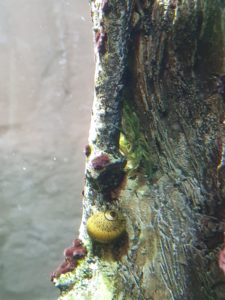
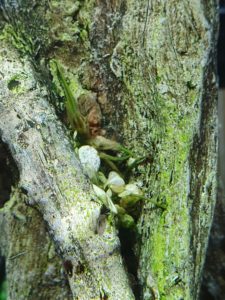
I can say that so far it hasn’t been an instant disaster. Not dramatically successful either, but the plant is still in there mostly holding its own. It definitely doesn’t look like it has had a significant number of the white leaves ‘melted off’ but neither would I say it’s shown much (any?) evidence of new growth. There might be some green algae growth, but nothing too bad (I had expected much worse). These specimens above had been dislodged from their place on the mountain and wound up wedged against the intake of the powerhead. I took the opportunity to pull them out for these photos, but didn’t other do any cleaning or maintenance, and wedged them back into place in the tank. The plantlets coming loose like this has happened before and is infrequent but not unusual. I haven’t tied or glued them in place, just wedged them in, and I quite suspect that they are being periodically dislodged by zebra thorn snails, who seem to be the little miniature juggernauts of the aquarium. In theory the anubias will grow roots that will attach themselves more firmly to their substrate, but I haven’t seen evidence of that happening either.
I think we’ll call it a draw for now – the snow is still in the game.
It is relatively straightforward to use the visual editor of WordPress or BoldGrid to embed pictures and have text flow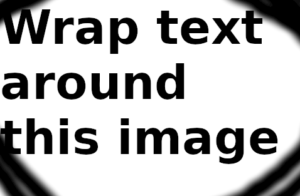 smoothly around the picture to either the right or the left: Insert the picture using ‘Insert Media’ from the column tab, then select the picture in the visual editor, click the ‘edit’ icon, and then click on the icon for picture positioning on the right or left. Centre puts the picture in the centre of the column, but text doesn’t otherwise flow around it. It can be a little fiddly, but it mostly works. You can then drag the image around to reposition it within a paragraph as well.
smoothly around the picture to either the right or the left: Insert the picture using ‘Insert Media’ from the column tab, then select the picture in the visual editor, click the ‘edit’ icon, and then click on the icon for picture positioning on the right or left. Centre puts the picture in the centre of the column, but text doesn’t otherwise flow around it. It can be a little fiddly, but it mostly works. You can then drag the image around to reposition it within a paragraph as well.
The problem is, you can’t do the same thing with an embedded video. You can construct a dedicated row and column setup to contain the video but then it’s complicated to get the text to flow around that structure correctly, particularly across different viewing platforms. I’ve done a lot of searching and getting text to wrap around an embedded video using only the visual editor is a “can’t get there from here” situation.
